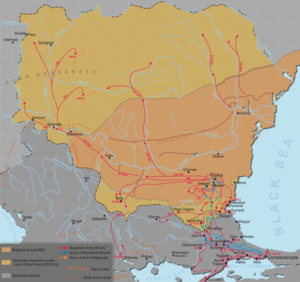This article has multiple issues. Please help improve it or discuss these issues on the talk page. (Learn how and when to remove these messages)
|
| Battle of Versinikia | |||||||
|---|---|---|---|---|---|---|---|
| Part of the Byzantine-Bulgarian Wars | |||||||
 Bulgaria under Khan Krum including the most important campaigns and battles | |||||||
| |||||||
| Belligerents | |||||||
| Bulgarian Empire | Byzantine Empire | ||||||
| Commanders and leaders | |||||||
| Khan Krum | Michael I Rangabe | ||||||
| Strength | |||||||
| 6,000–7,000[1] or 12,000[2] |
20,000[3]–30,000[2] 30,000–36,000[4] | ||||||
| Casualties and losses | |||||||
| Unknown | 2,000–3,000[5] | ||||||
The Battle of Versinikia (Bulgarian: Битката при Версиникия; Greek: Μάχη της Βερσινικίας) was fought in 813 between the Byzantine Empire and the Bulgarian Empire, near the city of Adrianople (Edirne) in modern-day Turkey.
The Bulgarian army led by Krum of Bulgaria defeated a larger Byzantine force. Following the defeat, Michael I Rangabe abdicated, with Leo V the Armenian taking the throne.[6] The battle further strengthened the Bulgarian position after their victory over Nicephorus I two years earlier. After the battle the Bulgars had de facto control of the whole region of Eastern Thrace (until the Byzantine–Bulgarian Treaty of 815) with the exception of a few castles that remained in Byzantine control. Krum died at the height of the preparations for the final siege of the Constantinople on 13 April 814.
- ^ Panos, p. 37
- ^ a b Haldon 2001, pp. 76–77
- ^ Panos, p. 237
- ^ Hupchick, p. 96
- ^ Hupchick, p. 101
- ^ LUTTWAK, EDWARD N. (2009-11-15). The Grand Strategy of the Byzantine Empire. Harvard University Press. ISBN 978-0-674-05420-2.